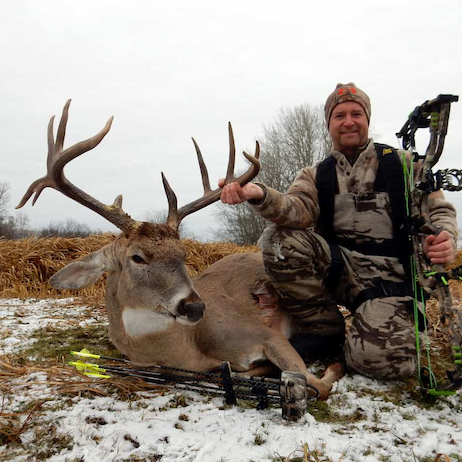You’ve heard all the hype around e-bikes. It’s piqued your interest, but you’re still unsure. Well, I’m here to tell you, e-bikes are a total game changer. They have literally opened up a world of opportunity for my wife and I. They’re quiet, durable, easy to ride. They’re powerful and fast, and they can haul loads. What more could any bowhunter ask for?
A few years ago, my wife and I picked up two Vamoose e-bikes for ourselves. We had heard so testimonials of how they could access more remote hunting spots quickly and quietly, we had to try them for ourselves. From the earliest warm-weather September hunts, through to our frigid November deer hunts, these silent marvels proved to be a game changer.
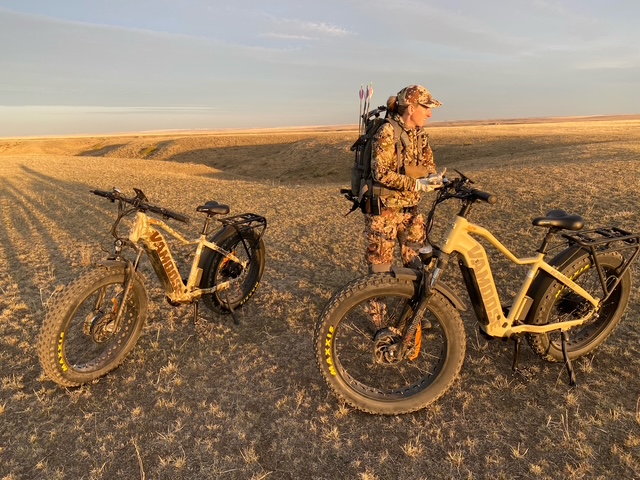
Allow me to share how things have played out for us over the past couple seasons. With all the hype around EV’s lately, here’s my disclaimer. I’ll temper my enthusiasm by stating that there are certainly a few limitations, but overall, as far as our bowhunting is concerned, the benefits far outweigh the negatives.
Our first real foray into the wonderful world of e-bikes was in September of 2022. My wife had drawn an antelope archery tag in southern Alberta. Easily transported in the box of our Tundra, offloading was simple. Heavier than a pedal mountain bike, with the fat tires, they are slightly more cumbersome to load and unload, but manageable. For most men, it’s not really an issue, but for most women, I’ve noticed it can be tougher.
If you’ve hunted the prairie grasslands, you know you’re glassing long distances, playing the wind, and using the topography to plan your approach. Go on foot, and you can literally kill hours covering miles of grassland and coulees trying to position yourself for an archery shot. I can’t tell you the number of times we spotted a buck working does several miles away, off-loaded the e-bikes, lifted them over barbed-wire fences and sped across the landscape hearing only the quiet hum of the electric motor. As a bowhunter, you quickly learn that not every stalk or decoying effort is successful. Add to this the fact that Heather only wanted a bigger buck, and her odds went way down. That meant doing many different stalks and e-bike forays to get in close for a better look. After five days, she returned with a tag still in her hand, but I was blessed with an opportunity to sneak in and arrow a small bull elk.
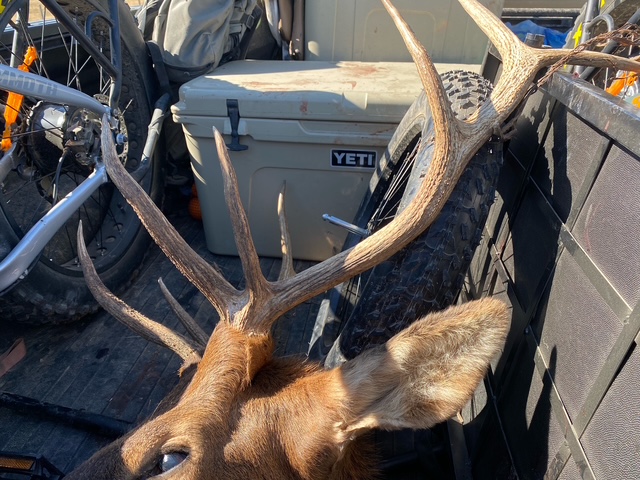
A few days later, Heather returned on her own. We picked up a single-bike rack for the trailer hitch on our truck. This made it much easier for her to load and unload on her own.
As far as performance is concerned, the e-bikes were amazing, especially during that early season, warm weather hunt. The fat tires handled well, but we learned to fill the tires with an armor lining to avoid getting flats from the cacti. The batteries lasted about 40 miles per charge. Next up was the moose rut.
The Moose Rut
A lot of moose habitat is boggy, but the area we hunt has a good mix of boggy, hilly, and solid dry terrain. Fortunately, it has a long cutline on high ground that leads deep into prime moose habitat. Each morning, 45-minutes before daylight, we would off-load our bikes from the truck, strap our bows to our daypacks, press the handlebar power button, and head out. The tiny LCD screen would illuminate and with a gentle twist of the throttle, we would silently roll away. With little more than a low-pitch hum, we could swiftly and quietly move into our hunting area. We traveled a backroad for a half-mile and then some distance down a cutline to where we would be hunting. Each bike was equipped with a headlight, but we turned them off, so all that showed was a brake light each time we slowed as we quietly ghosted in to our destination. What would have otherwise taken us a half-hour of hiking, now took less than 10 minutes. Leaving virtually no scent, and getting us in quick and easy, the first time we used them for moose hunting, we were amazed with their efficiency.
Quiet Transport
E-bikes are unbelievably quiet. A subtle hum is about all you hear. You can use pedal power, or electric power, or a combination of both. As bowhunters, our goal is usually to get into our hunting spots as quietly, and as scent-free, as possible. We need to do it in a way that doesn’t alert the animals. I can’t think of a more efficient way to do this, than with an e-bike.
Rolling on 26” x 4.8” Maxxis fat tires, the ride with our e-bikes is remarkably smooth, even on uneven terrain. After putting our bikes to the test for antelope and moose, we also used them during our November mule deer hunt as well. We definitely put them to work, running over countless cacti, pounding them through major holes, hitting rocks, and finally with what I think was the ultimate test, running them in the hills and coulees with five-inches of snow and eventually hauling out a 200-pound deer on the bike trailer.
.
The best tip I can offer anyone considering an e-bike purchase for hunting, fishing, or other outdoor activities, is to give serious thought to all-wheel-drive. Not all e-bikes have this. Seeing now, how they really work, I can tell you the drivetrain on our bikes is a power horse. Both of ours have dual drive. Mine is a 750W, and Heather’s is a 500W. Both are powered by a 52-volt 20-amp hour Samsung lithium-ion battery system equipping our Mammoth bikes with 1040 watt-hours for impressive thrust. Our bikes have two brushless 52V motors for both the front and rear wheels. Snow and cold was the ultimate test that sealed the deal for me.
Versatility
Consider the possibilities, and it’s hard to deny the value of an e-bike. The applications are endless. I know a growing number of bowhunters who already use e-bikes yearround for a variety of outdoor activities. I also know of several anglers who are planning to use them to access tough-to-reach stretches of rivers and streams. There are limitless opportunities for checking and maintaining trail cameras, riding in to and out of bear bait sites, spot and stalk hunting many different species, fishing backcountry lakes and streams, ice-fishing any time the snow is either minimal or melted, and even shed hunting in late spring. Accessorize your e-bike with a trailer and suddenly you’ve got the ability to haul gear and other necessities. Our most significant observation with the trailer, is that the hitch design minimizes tongue weight, allowing the rider to carry a substantial load with minimal effect on the bike and drivetrain itself.
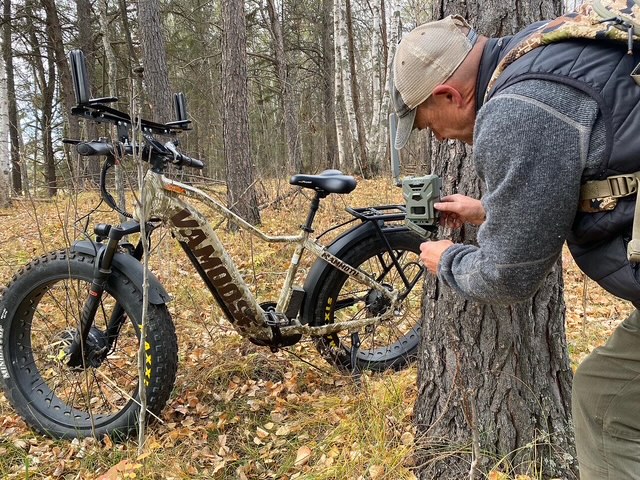
While e-bikes are definitely impressive, they have limitations. Pedaling to assist propulsion, helps conserve battery life. The torque sensor measures how much the rider is assisting, to send sufficient power to push the bike. Electric means it requires a charge, and the battery will only take you so far. Charging takes time; usually a couple hours give or take for a full recharge. While in warmer weather we can generally travel up to 40-miles, with rough terrain this is more limited and variable. Add in frigid temperatures, and battery life becomes more unpredictable. Solutions include using battery warmers and carrying one or more spare batteries. In the end, you’re still using an EV and, in their present form, there are restraints.
Pneumatic tires are vulnerable to puncture. Fat tires are especially tough, but they are not invincible. As I mentioned before, the armor-plating liner is a great idea, but it’s not cheap. Considerably more affordable, you can add a product called Slime – a two-in-one product that prevents and repairs flat tires. It works fairly well, but in my experience, the armor is better.
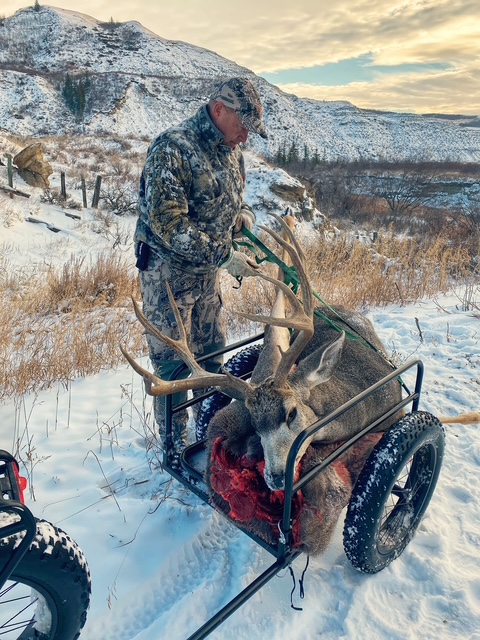
Responsible Use
As with all good things – and believe me, these e-bikes really are great – perspective and accountability are in order. Yes, they can get you into remote areas quickly and efficiently, but with that comes responsibility. I know many people are concerned about ongoing access issues, and rightfully so. I caution every e-bike user, to recognize the potential negatives and responsibilities that accompany any privilege. Familiarize yourself with regulatory restrictions in the areas you hunt. Rest assured, if people choose to use them irresponsibly, those liberties will become more regulated over time. Be sure to check with your local authorities, to ensure that e-bikes are allowed for accessing your hunting spots, and that they are in fact allowed to be used while hunting.
If you’re thinking about getting an e-bike, be sure to research well before taking the plunge. For bowhunters, they are a serious game changer well worth considering.
